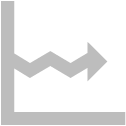What do we mean by ‘trend’?
Groundwater quality is always changing. It may show short-term changes, like responses to rainfall events, chemical spills or groundwater pumping. It may show seasonal cycles, and it may respond differently to periods of wet or dry years. On top of these shorter-term variations, groundwater quality may also show gradual changes over periods of many years or decades.
It is these longer-term changes that we refer to as ‘trends’. The trend is the overall direction of change over the selected time period. LAWA presents trends calculated for the last 10 and 15 years for groundwater quality.
What water quality indicators does LAWA show trends for?
LAWA shows 10 and 15-year trends for five groundwater quality indicators: chloride, dissolved reactive phosphorus (DRP), E. coli, electrical conductivity and nitrate nitrogen.
LAWA trend categories for groundwater quality
LAWA categorises trends into five classes. These are: very likely degrading, likely degrading, indeterminate, likely improving, and very likely improving. These likelihood definitions simplify the framework laid out by the Intergovernmental Panel on Climate Change (IPCC), (Stocker et al., 2013).
Note that the trend confidence categories do not reflect the rate of change, this is how quickly values might be rising or falling, only how confident we can be that the values are changing. The actual changes might be very small, even for sites with high confidence that they're changing in a certain direction.
Improving Trends
 |
 |
| Very likely improving trend | Likely improving trend |
The improving trend symbols are used for sites that show an improving trend in water quality and are either classified as 'very likely improving' or 'likely improving'. For the five groundwater quality indicators on LAWA, an improvement is a decrease in values over time.
When the trend evaluation method reports a confidence in an improving trend of between 90 and 100%, we assign a 'very likely improving' category. When the reported confidence is between 67 and 90% we assign a 'likely improving' category. The lower likelihood reflects that while these is an indication of an improving trend, these is less statistical support for it.
Indeterminate Trend
 |
| Indeterminate trend |
When the trend evaluation method reports confidence in either trend direction below 67% we assign an 'indeterminate' trend category. This classification is given to sites where there is insufficient evidence to confidently determine if water quality is showing an improving or degrading trend. An indeterminate trend means that the data do not show an upward or downward trend direction with sufficient statistical likelihood.
Degrading Trends
 |
 |
| Very likely degrading trend | Likely degrading trend |
The degrading trend symbols are used for sites that show a degrading trend in water quality and are either classified as 'very likely degrading' or 'likely degrading'. For the five groundwater quality indicators on LAWA, a degrading trend is an increase in values over time.
When the trend evaluation method reports confidence in a degrading trend of between 90 and 100%, we assign a 'very likely degrading' trend. When the method reports confidence between 67 and 90% we assign a 'likely degrading' trend. The lower likelihood reflects the fact that while these is an indication of a degrading trend, there is less statistical support for it.
Trend Not Assessed
 |
| Not Assessed |
Sites are not assessed for trends when they do not meet the criteria to be included in the trend analysis (e.g. there were not enough data/samples over the period, not enough variability in the data to assess a trend, too many samples in the data with results below detection-limit , or long runs of the same value).
How do we calculate water quality trends?
Data requirements
Groundwater quality trends are calculated for the last 10 and 15 years. Data are evaluated to determine whether water quality is showing improving, degrading, or indeterminate trends.
The data used to calculate groundwater quality trends is generally collected quarterly. A few wells are sampled monthly and have trends analysed in their monthly data instead of quarterly. If these wells do not meet the monthly data requirements, the monthly data are reduced to quarterly values by taking the median value for each quarter and trends are then evaluated on the basis of this quarterly data. Median values are used when multiple samples were collected within a quarter, in case of wells sampled quarterly. LAWA does not calculate trends for wells that are only sampled annually.
Monitoring wells are excluded from the analysis if they have less than 75% of the data expected, and data from less than nine (or thirteen) out of the last ten (or fifteen) years. They are also excluded if they have less than 75% of the most recent year’s (2023) data (3 of 4 quarters or 9 of 12 months).
Censored values (data that are less than or greater than laboratory detection limits) are substituted in the trend analysis, by very low or very high values. However, if too many of the data are censored due to the detection limit of the laboratory method, the trend evaluation can become unreliable, and we opt not to calculate it. We choose not to calculate trends where there are fewer than five total and three unique, non-censored observations. Sites which do not meet these requirements for trend analysis are reported as 'not assessed'. This label is also used when sites did not have enough measurements available, such as only six years of measurements available for ten-year trends.
The data requirements are summarised here:
- At least 75% of the expected data in the trend period
- At least 3 of 4 quarters or 9 of 12 months in the final year (2023) analysed
- At least 9 years must be represented in the data for 10-year trends and at least 13 years represented for 15-year trends.
- At least 5 non-censored values
- At least 3 unique non-censored values
The data requirements for trend calculation are quite strict, to ensure that the results are statistically robust. However, this also means that many wells do not have enough data for trend calculation. Several councils, such as Auckland, Bay of Plenty, Manawatu and Otago, have only established their quarterly monitoring programmes within the past ten years, so they do not yet have ten years of quarterly data. Some councils, such as Canterbury, Hawke’s Bay, Northland, Waikato and West Coast, have many wells in their monitoring programmes that are sampled only annually or bi-annually. The wells may have been monitored for many years, but they do not have quarterly data, so they do not meet the requirements for trend analysis.
The trend methodology
To determine whether water quality results are showing improving, degrading or indeterminate trends, LAWA follows the methodology of McBride (2018), as implemented in R functions (R Core Team) provided by LandWaterPeople (v2102). LAWA uses the trend analysis methods provided by LandWaterPeople (Snelder and Fraser (2019)), which assume that data will always show an increase or decrease over time. The LWP trend evaluation method reports the percentage confidence that the analysed data set features a decreasing trend. If the trend must be either decreasing or increasing, the percentage confidence of an increasing trend is simply one hundred minus the confidence of a decreasing trend. Further details can be found in guidance for the approach to calculating water quality trends (Larned et al, 2021).
Trends were calculated on data for one well and one indicator at a time.
The data for each well/indicator combination were tested for seasonal effects, and then analysed with either a seasonal or non-seasonal version of the non-parametric Mann-Kendall Slope Test. This test evaluates all pairwise combinations of the data, evaluating whether the later observation is higher or lower than the earlier observation, for each pair. The magnitude of the difference has no importance, only the sign. The seasonal version of this test compares the water quality data of each season separately which means any changes present are not hidden by seasonal patterns.
What do groundwater quality trends show us?
We use trend calculations to help us identify changes in groundwater quality possibly caused by human activities. By setting our minimum calculation period to 10 years, we disregard many of the shorter-term changes described above that might be caused by weather patterns or isolated contamination events. Even 10-year trends may be influenced by longer-term weather patterns, but they are more likely to indicate regional-scale changes in land use or land management practices.
The trends calculated on LAWA help us determine where changes in management have been effective and where further work may be needed, keeping in mind that changes in water quality often take years to be seen, and it may be decades for any restoration actions to show effect in water quality trend results.
Where do I find more information?
Larned et al. 2021. Guidance for the analysis of temporal trends in environmental data. Prepared for Horizons Regional Council and MBIE Envirolink. 99 pp.
LandWaterPeople (LWP). https://landwaterpeople.co.nz/
Snelder T & Fraser C. 2018. Aggregating trend data for environmental reporting. LWP Client Report 2018-01.
Snelder T & Fraser C. 2019. "The LWP-Trends Library: v2101 April 2021", LWP Ltd Report, p35.
Stocker T, Qin D & Plattner G (Editors). 2014. Climate Change 2013: The physical science basis: working group | Contribution to the Fifth Assessment Report of the Intergovernmental Panel on Climate Change. Cambridge University Press.
